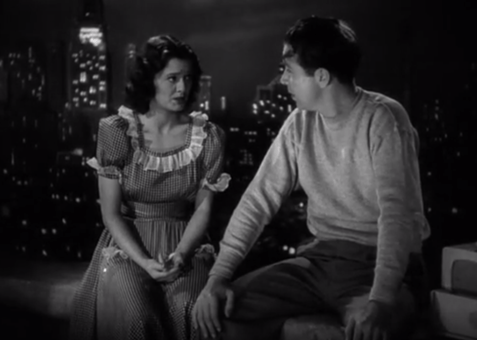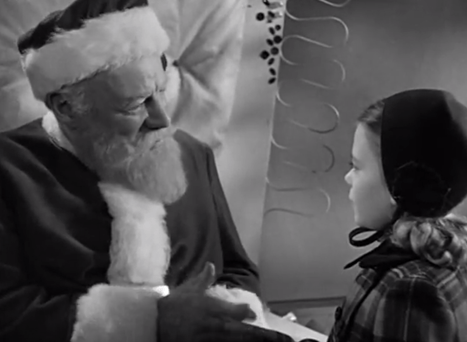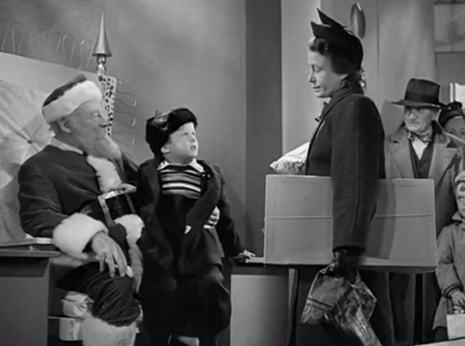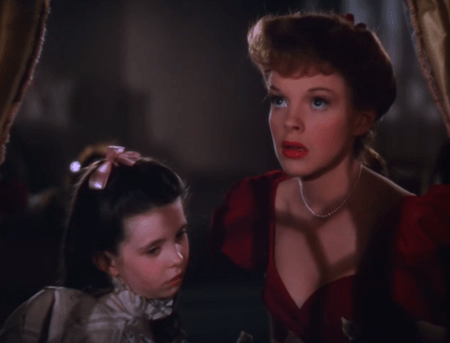
Christmas in Connecticut functions as a fine way to cap off 1945, a year full of jubilation and relief for the American public. The war was finally over! Given this context, the setup might feel familiar. A sailor who was shipwrecked out at sea in the Pacific was rescued. Now he’s seeing the war from the sidelines in a hospital.
Because in the mind of the viewer the war is already won, it feels like a relief. Jefferson Jones (Dennis Morgan) is an American hero, and all he has to worry about are building his strength and getting to know the pretty southern belle nursing him back to full health. Still, with the holidays approaching, he can’t help yearning for a little bit of good old-fashioned Americana, the down-home comfort and hospitality he’s missed out on overseas.
A letter of request gets sent on his behalf and the old battle-ax, famed magazine publisher, Alexander Yardley (Sydney Greenstreet) catches wind of it. The idea is to serve up the soldier a meal in the home of famed columnist Elizabeth Lane, known for her idyllic farm, snow-covered nostalgia, and domestic tips and tricks. (The character was based on real-life Gladys Taber of Family Circle Magazine who actually lived on a farm in Connecticut)
As he could use a bit of comfort and home cooking himself, Yardley thinks it’s a fine suggestion, and he’s prepared to invite himself and the soldier out to the country for the holidays. He has no thought that it might be an inconvenience.
But of course, this is hardly the problem. It’s worse than that. Elizabeth Lane does not exist, at least not as vividly as she does on the pages of Yardley’s magazine captivating nationwide audiences coast to coast.
In truth, she lives in a drafty apartment overlooking the outside laundry as she knocks away at her typewriter eating sardines for breakfast. Because she’s no cook nor a wife with a baby and a farm. She’s more of a city girl living off a diet of independence and mink coats. Of course, no one knows about the sham aside from her and her editor.
What makes it worse is the fact Mr. Yardley is a very principled fellow and a stickler for printing the truth. If he ever caught wind of this charade, it would be the end. So to take stock of the damage, her boss is about to show up on her doorstep (one which she doesn’t have) for Christmas eve with an unwitting soldier who believes in what she comes to represent.
Barbara Stanwyck dons this kind of part with ease as the street-wise lifestyle columnist. She rides out the comedy with her usual aplomb, but she can play romance and the sentimental in a manner that doesn’t totally rob them of their import.
Men vying for her affection will be an ongoing theme throughout the picture and why not because Barbara Stanwyck is the picture of self-confident beauty with an undisputed vivacity.
The film is salvaged — from solely a narrative perspective — when she impulsively accepts the routine marriage proposal from her suitor, the wealthy businessman John Sloan. He’s been trying to get her hand in marriage for a time. This time she acquiesces and accepts. Might as well have some stability.
However, it’s also the decision leading the shambles around her to all slide into place. It gets to the point where they might have a fighting chance making the impression stick at least for a weekend. John will be her husband because he is, isn’t he? They’ll conveniently use his farm. Check. Uncle Felix (S.Z. Sakall) will come along to cook the meals. Now there’s just the issue of the baby…
They assemble everything to make a go at the charade. They call out a judge to perform the marriage before their arrivals show up. There’s one hitch. Jefferson shows up early! It’s a scramble to pull everything together but the game is on whether they like it or not!
Morgan is an old star I always find to be a bit blah if generally genial. Thankfully, the film is replete with a formidable supporting cast to round out the holiday household. Not least among them Sydney Greenstreet (in a rather uncharacteristic role), then S.Z. Sakall, and Una O’Connor.
Felix and Norah go to war in the kitchen with their equally pertinacious attitudes. After all, Sakall is the king of the kitchen and catastrophe while subsequently becoming the film’s most lovable secret weapon when the story gets convoluted and a savior is called to bring it back around.
The many scenarios are easy to list off: bathing the baby with company on hand, flipping flap jacks at the behest of Mr. Yardley, putting the cow to bed, and the most calamitous of all, the baby swallowing a watch! It’s the actual unraveling of the scenes which become most delightful because Stanwyck rides them out with her typical flair for situational comedy.
A major turning point comes at a festive dance where love blooms though it does give a strange impression to outsiders looking in. The “married” Mrs. Sloan looks to have taken a shining for the tall man in uniform and the feelings are mutual. But that’s quite out of the question. Think of the scandal. This would never do totally dousing the prevailing happiness brought on by the cessation of war.
Still, they take a magical sleigh ride together. Because one of them knows they are unattached and Morgan’s character is just naive and self-effacing enough for us to believe he would never have presumptuous intentions.
However, everything must come to a head as this is tantamount to Murphy’s law in cinema. In this movie, it’s thanks to a miscommunication and a kidnapped baby. One of the highlights of the movie is observing the subtle antagonism of Sakall toward Greenstreet. He mutters “Fat Man” which might be a fairly blatant reference to his incorrigible part in The Maltese Falcon.
However, they also go at it in the kitchen because Sakall is the glue and the matchmaker — everything required to hold the story together and see it to the desired ending. It means stopping Yardley in his tracks. In fact, these scenes are only topped by Stanwyck laying into the Fat Man of her own accord and then falling for Dennis Morgan as it’s meant to be. They really are 1 and 2 on the film’s greatest attractions.
In a movie such as this with snow, sleighs, a warm hearth, and friends and family, not to mention the end of WWII, what would the ending be without our protagonists wrapped up in each other’s arms? If you’re like wartime audiences with generous spirits, it’s excusable to find Christmas in Connecticut to be agreeable holiday entertainment as the mood strikes you.
3.5/5 Stars


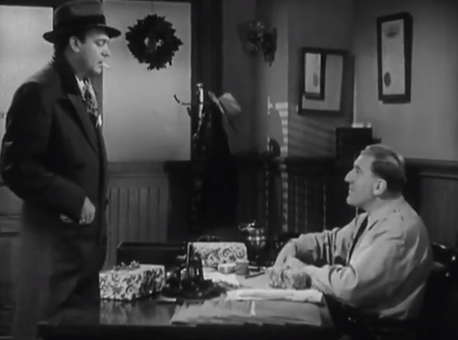


 Growing up in a household indebted to British everything, you get accustomed to certain things. Numerous everyday knickknacks and antiques imported from The U.K. Muesli Cereal in the pantry with copious amounts of English Breakfast Tea. Beatrix Potter, P.G. Wodehouse, and Postman Pat become household favorites.
Growing up in a household indebted to British everything, you get accustomed to certain things. Numerous everyday knickknacks and antiques imported from The U.K. Muesli Cereal in the pantry with copious amounts of English Breakfast Tea. Beatrix Potter, P.G. Wodehouse, and Postman Pat become household favorites. In viewing the 1951 version of the Christmas classic, I took particular interest in the name of our protagonist Ebenezer Scrooge, attempting to redeem it for the masses. For this picture, I was curious in considering another integral term in our lexicon: Humbug.
In viewing the 1951 version of the Christmas classic, I took particular interest in the name of our protagonist Ebenezer Scrooge, attempting to redeem it for the masses. For this picture, I was curious in considering another integral term in our lexicon: Humbug.